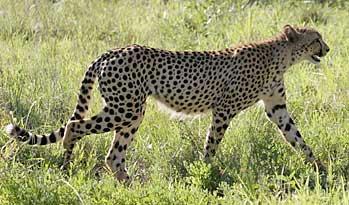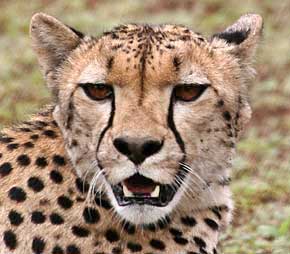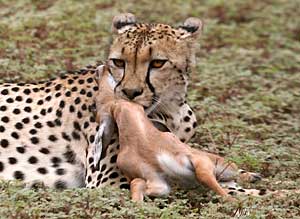Contact Details: Scotch Macaskill, Dirt Road Traders, Currys Post Road, Howick, KwaZulu-Natal, South Africa. Tel: +27 (0)82 578 2329. Privacy: Your privacy is guaranteed. See our Privacy Policy for more. This site accepts advertising and other forms of compensation - see Disclosure and Advertising for details. Site updated: 2022. Copyright © 2002 - 2022 Scotch Macaskill

| ||||||||||
|
||||||||||
|
See also info about: |
Cheetah Information
Appearance:
The word "cheetah" comes from the hindi word meaning "spotted one". An adult has yellow or tan fur with solid black, round, or oval spots which cover nearly the whole body. Only the white throat and abdomen are unmarked. The tail ends with four to six black rings and a bushy, white tuft. The eyes are set high on its head and a black "tear mark" runs from the inner point of the eye down to the corner of the mouth. Behavior:
The adult female cheetahs are usually solitary, but their cubs stay with their mothers for at least a year. Adult males often live in small, strong groups or coalitions. Males hold territories for up to six years, which they mark by spraying urine. Cheetah are usually found on open plains or light woodland where they can more easily chase down their prey.
Reproduction:
Hunting:
When hunting, cheetah stalk up close to their prey and then sprint in for the kill. They are the fastest land mammals on earth and can reach a top speed of 70km per hour, but this speed can only be maintained for a few hundred metres. Once within striking distance, they will trip their quarry with a swipe of the front paw, then smother the victim by clenching the throat with their teeth. These streamlined cats are, however, usually successful in only two out of seven hunting opportunities. Cheetah are also mild-natured and non-agressive, so will often lose their kill to other, more agressive predators like lions or spotted hyenas. See Cheetah and Hyena Confrontation for more on this.
Diet:
Sounds:
Status:
For additional information about the cheetah, see our gallery of Cheetah Pictures and our picture sequence, Cheetah Cubs Practice Hunting Skills. Return to Wildlife Info
|
|||||||||
|
|
||||||||||

 Cheetah headshot showing "tear marks" running
Cheetah headshot showing "tear marks" running 